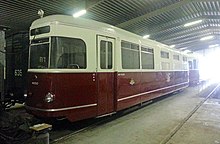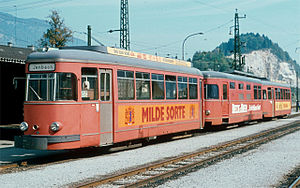RTM M 17
| M 17.01 - M 17.00 - M 17.02 VT1 EB 1701 - MBD 1700 - EB 1702 |
|
|---|---|
| Numbering: | RTM: M 17 Zillertalbahn: VT1 |
| Number: | 1 train of 3 cars |
| Manufacturer: | Railcar: Duewag MBD:? / Hoogeveen / RTM |
| Year of construction (s): | 1954 / 1961–1963 |
| Type : | 2'B'g1t + 2'2 '+ B'2'g1t |
| Gauge : | 1000 mm (railcars up to 1961) 1067 mm (1963–1969) 760 mm (1969–2002) 1067 mm (since 2002) |
| Length over buffers: | 45,190 mm |
| Height: | 3350/3200/3350 mm |
| Width: | 2200 mm |
| Trunnion Distance: | 6000 mm |
| Bogie axle base: | 1800/1400/1800 mm |
| Total wheelbase: | 7800/7400/7800 mm |
| Service mass: | 16.2 t + 20 t + 16.2 t |
| Top speed: | 60 km / h |
| Continuous output : | 110 - 92 - 95 - 115 kW per railcar |
| Performance indicator: | 210 HP (154 kW) generator 92 kW per drive motor |
| Driving wheel diameter: | 660 mm |
| Impeller diameter: | Motor car 660 mm generator car 750 mm |
| Power system : | 700 - 600 - 750 volts = |
| Power transmission: | Generator car |
| Number of traction motors: | 1 per railcar |
| Coupling type: | On the train: automatic central buffer coupling Ends: central buffer coupling with screw coupling below |
| Seats: | 34 per railcar 13 in the generator car |
| Standing room: | 36 per railcar |
| Classes : | 2. |
The RTM ( Rotterdamsche Tramweg Maatschappij ) created the diesel-electric multiple unit M 17 for its interurban tram operation from 1961 to 1963 from the two large-capacity electric tram cars of the DB series ET 195 built in 1954 and a generator car with a new body based on an old internal combustion engine. All three vehicles were fundamentally redesigned. The two railcars had to be changed from meter gauge to cape gauge (1067 mm) , among other things .
Re-gauged again, but unchanged in terms of drive technology, the train finally ran for almost 30 years as the VT1 on the Zillertalbahn ( ZB ) in Austria . In the meantime, it has been reduced to the Cape gauge and is now used on the museum railway of the Stichting voorheen RTM (Foundation former RTM) near Rotterdam, which stores a large number of former RTM vehicles.
Railcar
In 1954, the acquired German Federal Railways (DB) for the state-owned tram Ravensburg-Weingarten Baienfurt at Duewag two Duewag open seating car with electrical equipment from Kiepe . The two cars with the serial numbers 26887 and 26888 were put into operation on April 9, 1954 and were sometimes used together in double traction .
After the final decision to discontinue the tram to Baienfurt in 1961, they came to RTM that same year, which re-gauged them to the Cape gauge and made some modifications. The double doors were converted into single doors and the door panels obtained in this way were installed on the side of the vehicles that had previously been doorless. In addition, one driver's cab was removed and the pantograph dismantled. At the ends of the train, the Scharfenberg couplings were replaced by central buffers with screw couplings underneath.
Generator car
Since there was not enough space for a generator in the railcar, a generator car was also needed. This was created in 1963 at NV Carrosseriefabriek Hoogeveen from the 1914 built diesel multiple unit D II of the Maas local railway ( Nijmegen - Gennep - Venlo ), classified as M 66 at the RTM. Its undercarriage, however, was in such poor condition that a new undercarriage was required in addition to the new steel body that was planned and adapted to the Duewag wagons. The bogies came from an old passenger car. The car had a diesel engine with an output of 130 kW. It is as long as the railcars and includes the second driver's cabs removed from the railcars at the ends, the engine room in the middle, a luggage compartment in between and a small passenger compartment with 13 seats in the other, which became a bicycle compartment on the Zillertalbahn and now serves as a restaurant.
commitment
The train can be used either as a three-car train with the generator car as an intermediate car or as a two-car train with the generator car as a control car . The entire train was uniformly painted in the usual RTM colors, red and cream. Since the generator only generated a voltage of 700 volts, as opposed to 750 volts from the overhead line of the Ravensburger Bahn, the motors only produced 92 kW instead of 110 kW.
The team was designated at the RTM with the company numbers M 17.01 (formerly ET 195 01), M 17.00 (generator car) and M 17.02 (formerly ET 195 02) and was nicknamed Sperwer , Dutch for sparrowhawk .
After four and a half years of conversion, the cars were back in regular passenger service on December 2, 1963. However, the RTM network was shut down soon afterwards; the last day of operation was February 14, 1966.
Sale to the Zillertalbahn
In 1967 the train was sold to the Austrian Zillertalbahn - just four years after the extensive renovations - and it was loaded in Rotterdam on June 26, 1967. This tracked it again, this time to the so-called Bosnian gauge of 760 millimeters. The Zillertalbahn used the team under the designation VT1 from February 1970 to 1997 in regular train operations, after that only as a reserve train.
In 1971 the old bogies of the generator car were replaced by used and re-tracked ones from the stock of the Cologne transport company . In the long years of operation, the traction motors from the DB era were exchanged for used ones from the Viennese tram , which initially had an output of 95 kW, and later, after increasing the operating voltage to 750 volts, 115 kW. As early as the first half of the 1970s, the train was given a new paint job, orange all over. In 1980 the paint was two-tone again. During a complete renovation in the winter of 1986/1987, the cars were repainted.
Sale to the RTM museum railway
After the Zillertalbahn modernized its vehicle fleet and no longer needed the train, the combination was retired in 1999 and returned to the Netherlands on October 8, 1999. Since then it has been located at the museum railway Stichting voorheen RTM , German foundation former RTM , in Ouddorp . In 2002 the train was repaired with the support of the Essener Verkehrs-AG workshop and restored to its condition from 1959; it has been in use since October 2003 on the approximately eight-kilometer museum route between Ouddorp, Port Zelande and Middelplaat-Haven. Its current numbering is EB 1701 - MBD 1700 - EB 1702.
Web links
- Detailed description of the train on rtm-ouddorp.nl (Dutch, PDF; 3.70 MB)
- Images and information on the use at the Stichting voorheen RTM (Dutch)
- Pictures from the return transport to the Netherlands
- More pictures of the current state on www.drehscheibe-foren.de, including interior shot


